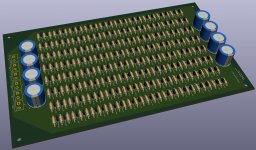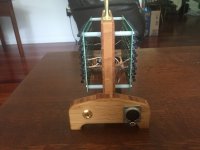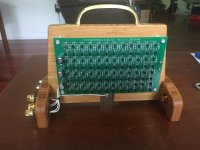Third iteration of massive complementary buffer. 80 buffer pairs for headphone usage and flea power speakers.
6-layer board allows no hand routing between buffers. I only had to route one buffer and clone the rest. The cloning plugin also can arrange a matrix of identical circuits.
All of the circuit nodes have their own copper layer.
To me this is the most interesting. It has a lot of good things:
Available jfets
Hand soldered
Cheap and easy
Good looking
Headphone/mini amp/preamp all in one.
No feedback
I have several 12v 4amp transformers. I'm tempted to try it 😀.
80 buffer pairs for headphones or supersensitive speakers.Growing interest here 🙂
BR,
Ernst
I think the "full blown" power amps are the most interesting.
The TO-92 version gives a bit freedom to e.g. match the devices if this can enhance performance. The smd version makes it a bit easier to just purchase a number of mounted and tested boards?
Think it also depends on how they each performs when a prototype is tested?
The TO-92 version gives a bit freedom to e.g. match the devices if this can enhance performance. The smd version makes it a bit easier to just purchase a number of mounted and tested boards?
Think it also depends on how they each performs when a prototype is tested?
80 buffer pairs for headphones or supersensitive speakers.
BR,
Ernst
The first pcbs should in my hands by late next week. I will post results here when I have some news to report.
80 buffer pairs for headphones or supersensitive speakers.
BR,
Ernst
I think the "full blown" power amps are the most interesting.
The TO-92 version gives a bit freedom to e.g. match the devices if this can enhance performance. The smd version makes it a bit easier to just purchase a number of mounted and tested boards?
Think it also depends on how they each performs when a prototype is tested?
Yes to all of that. The SMT version will be a massive B1 instead of a complementary buffer as in the original Beast with a thousand JFETs by Mr. Pass. I cannot find any complements that have reasonably low Rds_on. All of the P JFETs in SMT that I can find have Rds_on 4X greater than the 2SK2145 N JFET by Toshiba.
Hi Woofertester, this is amazing work! Well done! 
Will you be offering boards? Will there be a version of the 1280 jfet as well?

Will you be offering boards? Will there be a version of the 1280 jfet as well?
I have the first 4 layer boards in hand. Checking the cross-talk before installing any Rs or Qs.





As noted, Nelson is exploring different “beast” topologies. The picture below is one of his micro-beast topologies: 48 parallel cells, each cell consisting of a J113 jfet follower with a J113 jfet CCS. The poor design is purely my fault.
The micro-beast makes a wonder headphone amplifier. The 32 ohm output impedance drives my Final Audio D8000 headphones and even my Abyss 1266 TC. The micro-beast sounds as good in one minute as is one hour.
As expected, the single-ended topology yields a 2nd harmonic output. I’m running it with +- 12 vdc. Since it is a follower, voltage is not critical as long there is a volts of headroom. Each side draws 1.6 amps.i
The micro-beast makes a wonder headphone amplifier. The 32 ohm output impedance drives my Final Audio D8000 headphones and even my Abyss 1266 TC. The micro-beast sounds as good in one minute as is one hour.
As expected, the single-ended topology yields a 2nd harmonic output. I’m running it with +- 12 vdc. Since it is a follower, voltage is not critical as long there is a volts of headroom. Each side draws 1.6 amps.i
Attachments
As noted, Nelson is exploring different “beast” topologies. The picture below is one of his micro-beast topologies: 48 parallel cells, each cell consisting of a J113 jfet follower with a J113 jfet CCS. The poor design is purely my fault.
The micro-beast makes a wonder headphone amplifier. The 32 ohm output impedance drives my Final Audio D8000 headphones and even my Abyss 1266 TC. The micro-beast sounds as good in one minute as is one hour.
As expected, the single-ended topology yields a 2nd harmonic output. I’m running it with +- 12 vdc. Since it is a follower, voltage is not critical as long there is a volts of headroom. Each side draws 1.6 amps.i
Very cool. Nice seeing the J113’s in play.
Hi Woofertester, this is amazing work! Well done!
Will you be offering boards? Will there be a version of the 1280 jfet as well?
Yes and yes. I will offer boards at my cost when I know that the design and the boards work as intended.
The 1,000+ piece boards will be SMT and will have to be built at a board house.
As noted, Nelson is exploring different “beast” topologies. The picture below is one of his micro-beast topologies: 48 parallel cells, each cell consisting of a J113 jfet follower with a J113 jfet CCS. The poor design is purely my fault.
The micro-beast makes a wonder headphone amplifier. The 32 ohm output impedance drives my Final Audio D8000 headphones and even my Abyss 1266 TC. The micro-beast sounds as good in one minute as is one hour.
As expected, the single-ended topology yields a 2nd harmonic output. I’m running it with +- 12 vdc. Since it is a follower, voltage is not critical as long there is a volts of headroom. Each side draws 1.6 amps.i
Sweet. Nice to see a close up of the master's design.
I have looked at the J113. The 2SK2145 is much more appealing to me as the Rdson is lower. I came up with a figure of merit where gm is at least Idss. As an example, if Idss is 8mA, gm is at least 8 milli- siemens. For the 2SK170 , gm is much larger than Idss. For the J113, I remember that gm is much less than Idss. That is just from memory.
The J113 was not intended to be the best choice for a micro-beast. Nelson has thousands of J113s, and they are cheap. With careful matching of the jfets the micro-beast has a DC offset of 2 mV. Nelson doesn't do surface mount parts.
The Toshiba 2SK2145 is an attractive part. Zen Mod uses them in the buffer section of his Iron Pumpkin, a brilliant sounding design. If I understand correctly, the Iron Pumpkin preamp uses two strategies to handle the DC offset problem. First, matching the 2sk2145s. Matching requires a special jig to measure the jfet. Second, adjusting the supply voltages to achieve low DC offset. Zen Mod suggested that his buffer design would make a good front for a micro-beast. Also Iron Pumpkin buffer's low output impedance will help drive the collective gate capacitance of paralleled jfets.
The Toshiba 2SK2145 is an attractive part. Zen Mod uses them in the buffer section of his Iron Pumpkin, a brilliant sounding design. If I understand correctly, the Iron Pumpkin preamp uses two strategies to handle the DC offset problem. First, matching the 2sk2145s. Matching requires a special jig to measure the jfet. Second, adjusting the supply voltages to achieve low DC offset. Zen Mod suggested that his buffer design would make a good front for a micro-beast. Also Iron Pumpkin buffer's low output impedance will help drive the collective gate capacitance of paralleled jfets.
No doubt the J113 is not the preferred choice, but having a TH, cheap, obtainable part does have appeal. A beast for the masses 🙂
Which Jfets will you be evaluating in the 80 buffer pairs version? I'd be really interested in that design for headphone use.
As noted, Nelson is exploring different “beast” topologies. The picture below is one of his micro-beast topologies: 48 parallel cells, each cell consisting of a J113 jfet follower with a J113 jfet CCS. The poor design is purely my fault.
The micro-beast makes a wonder headphone amplifier. The 32 ohm output impedance drives my Final Audio D8000 headphones and even my Abyss 1266 TC. The micro-beast sounds as good in one minute as is one hour.
As expected, the single-ended topology yields a 2nd harmonic output. I’m running it with +- 12 vdc. Since it is a follower, voltage is not critical as long there is a volts of headroom. Each side draws 1.6 amps.i
What poor design you refers to? It's magnificent!! I like even the brass handle 🙂
Which Jfets will you be evaluating in the 80 buffer pairs version? I'd be really interested in that design for headphone use.
Look at post #56. I have enough of these for a balanced stereo pair.
I acquired the parts at Arrow and Rochester Electronics.
The pinout of the JFETs I chose are the same as LSK170/J74. You could use the Linear Systems parts. Kind of spendy.
- Home
- Amplifiers
- Pass Labs
- Beast with 1000 JFETs redux?



